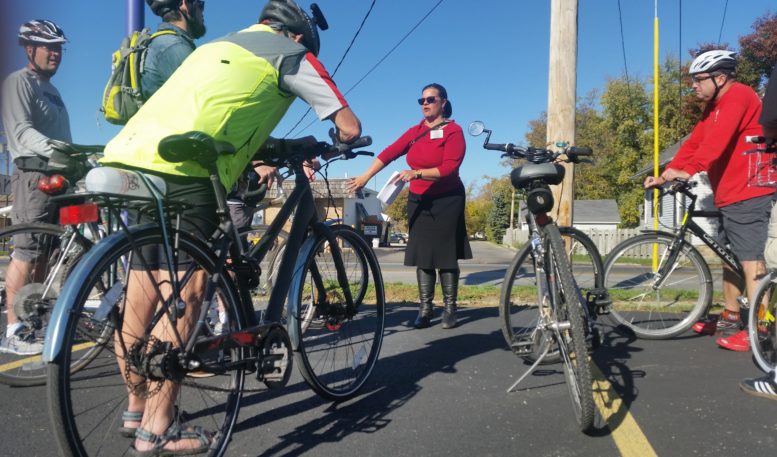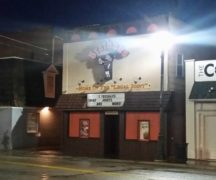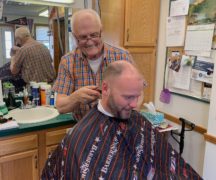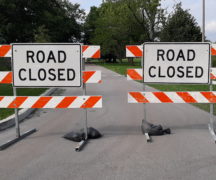By JAN LARSON McLAUGHLIN
BG Independent News
Maybe Bowling Green doesn’t need to spend thousands of dollars on a scattered patchwork of bike lanes to make city streets more friendly to cyclists. Maybe the four-wheeled and the two-wheeled motorists just need to learn how to co-exist on the roads.
On Monday, two groups of city leaders took bike tours of the community. They rode quiet residential streets like Eberly, and busy four-lane streets like Main Street.
“No one ever honked at us,” said Catherine Givres, an educator with YaY Bikes, whose mission is to get “more butts on more bikes, more often.”
The ride was an eye-opening experience for several of the bicyclists.
“I’ve cycled for over 60 years, in multiple countries,” said Steve Langendorfer, president of the city’s Bicycle Safety Commission. “I bike thousands of miles every year.” During those years, he has consistently hugged the edge of the road – trying to be courteous to motorists and trying to take the safest spot on the road.
But on Monday, Langendorfer and the others rode a few feet into the road, about where the passenger tire of a car would travel. “It was fascinating,” he said.
Cars did not whiz by just a few feet from the bicyclists. When the ongoing lane was clear, the cars swung wide around to pass.
That’s one of the keys, said Givres. Bicyclists should not think of themselves as in the way of traffic. “You are traffic,” she said. “It is not rude to take up space on the road.”
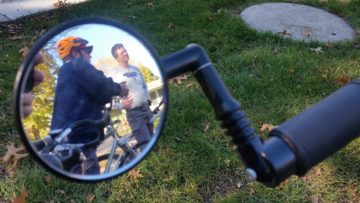
Cyclists stop to discuss issues along the route.
Ohio law considers bikes as “street legal vehicles.” They have the right to take up space on the road – and the responsibility to follow the same rules as motorized vehicles. They are allowed to ride two abreast on the road, and are permitted on any roads except highways.
“They are not impeding traffic. They are traffic,” Givres said.
In addition to bicyclists needing to learn their rights, they also need to make sure they follow the rules. That includes using turn signals and coming to a complete stop at stop sign – not just coasting through. However, Givres said two-wheel travelers don’t break the rules any more than their four-wheel neighbors on the road.
“Cyclists break traffic laws at slightly lower levels than motorists,” she said.
But cyclists should realize that their behavior needs to be predictable for the faster moving motorists. That is another reason for bicyclists to not hug the edge of the road, where they often have to swerve into the lane to avoid hazards like debris, grates and potholes.
“Your intentions to be polite unintentionally create more chaos on the road,” Givres said.
Drivers don’t want to hit bikers, she stressed. “Even people who are openly disdainful of bikers. They don’t want to have to get bodywork on their car.”
Ohio law allows motorists to pass over the double yellow line if a bicyclist is going less than half the speed limit.
“Most cyclists are not trying to impede car traffic. And most cars are not trying to scare cyclists,” Givres said.
Streets are far safer for bicyclists than sidewalks, she added. Cyclists are two to four times more likely to get hit by a car on a sidewalk, since they often don’t stop at every driveway.
Bicyclists are more than just the young urban hipsters, or the fit spandex-wearing riders, Givres said. Some choose to bike for the environment, some for their health. For others, the choice is made by their economic situation. But there are a lot of “average” people who would like to ride their bikes in communities – but just don’t feel safe.
According to Givres, 50 to 60 percent of people nationally would like to occasionally use their bicycles to get around in their communities. “People are interested. But they feel nervous being on the road with cars.”
The problem has many possible solutions in engineering, education, encouragement, enforcement, equity and evaluation.
“Engineering is often asked to do all the heavy lifting,” and can be quite costly, Givres said. A solution that combines all of the above is best.
Bowling Green Fire Chief Tom Sanderson, who led the YaY Bikes tours on Monday, said education is a great start since it’s more affordable and more likely to benefit more bicyclists than a couple costly bike lanes.
“You’re going to need bike lanes everywhere, and that’s not practical,” he said, adding that education is a better investment. “That stripe of paint is not going to protect that bicyclist.”
Sanderson, who used to bike to work in Bowling Green from Perrysburg, said he was surprised to hear that others felt BG was not bike-friendly.
“I never realized what a horrible community this is to bike in,” he said, adding that he has found it to be just the opposite. “I think this is a bike-friendly community. This is a great place to ride a bicycle.”
Bowling Green City Engineer Jason Sisco agreed. “Our streets are pretty ride-able, but people don’t realize it.”
But Bowling Green Council member Daniel Gordon said physical accommodations also need to be made. “We can do better,” he said.
Givres said there are no well-defined rules for community bike accommodations yet. She didn’t want to discourage Bowling Green officials from installing bike lanes or other expensive solutions, but added that it might be wise to wait. “There is something to say about learning from other people’s mistakes,” she said.
Givres suggested that Bowling Green officials travel to other communities to learn what does and doesn’t work. She predicted that within five years, Ohio will have better guidelines in place for bike accommodations.
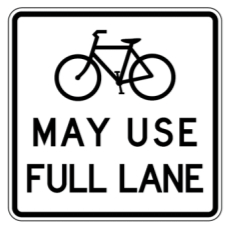
Some communities use this sign to explain cyclists’ rights.
She offered some tips to consider prior to making any decision:
- Making streets one-way or removing on-street parking can make room for bikes, but it also widens the street – which makes motorists feel they can drive faster.
- One-way streets in commercial corridors reduce economic activity.
- Don’t remove trees to make room for bikes. Trees calm the speed of traffic.
- “Share the road” signs often confuse motorists, leading them to think they have a choice to share or not.
- Some communities use signs saying “bikes may use full lane,” which are more direct.
- Sharrows are worthy of consideration, and are “love letters from engineers to the community,” and can be kept clean year-round by street snowplows.
- There is a difference between multi-use paths and transportation corridors. Let the parks or health departments build recreational paths, the city needs to focus on getting bicyclists to destinations.
Penny Evans-Meyer, who often bicycles in town, said her experience on city streets is different than those of the bike tour groups Monday. “When I go by myself, it’s a totally different thing,” she said.
Education for motorists and cyclists is key, Givres said. No YouTube video will do. She suggested that people in the community be trained to lead bicyclists on educational rides to teach them their rights and responsibilities.
Bowling Green can also encourage bicycling by putting bike racks in more places. A program can be created to recognize “bike-friendly businesses,” that agree to refill water bottles, let cyclists use restrooms, pass out maps, and have parking accommodations near front doors.
Givres said the fact that ODOT is funding groups like YaY Bikes to train engineers around the state is a significant change. “Five years ago, there’s no way in hell this would happen.”
“There are allies out there to help you figure things out. You don’t have to do it alone,” she said.

